Dog Days
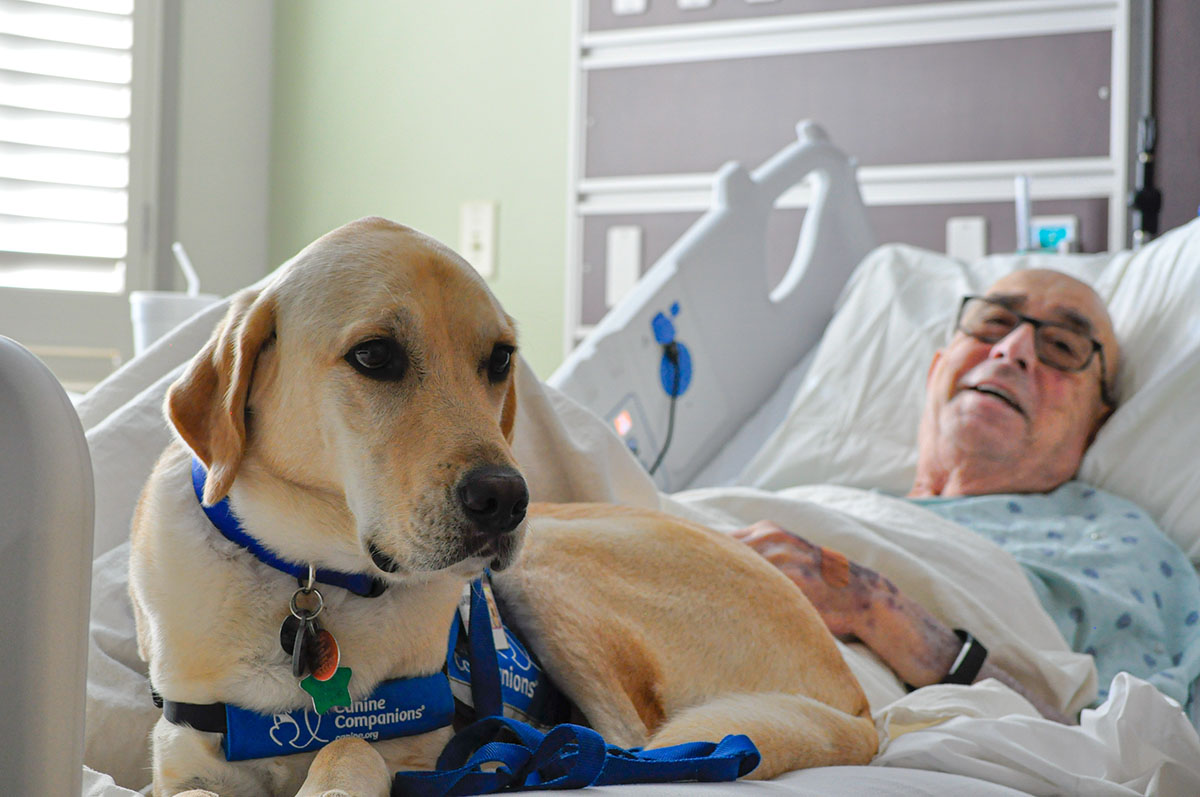
Jammer, a Health First facility dog, visits retired U.S. Army Col. Benjamin Abramowitz, a patient at Viera Hospital. MORGAN MCNEAL
Local hospitals are ‘hiring’ specialists in joy
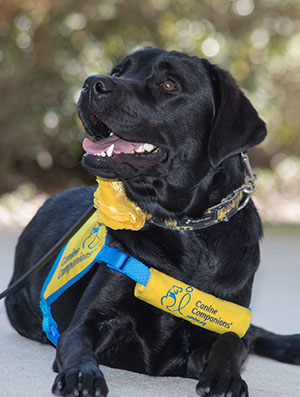
Wallie often accompanies therapy dog Vista VI and owner Sandra Block on their volunteer rounds at Health First hospitals, but come November, the pup will head to Orlando for advanced training at Canine Companions. HEALTH FIRST
If dogs could be awarded advanced degrees, Jammer would have a Ph.D. diploma hanging in his doghouse. To earn his place as a Health First facility dog, Jammer had to successfully complete intensive training at the Orlando campus of Canine Companions. Since 1975, the national nonprofit has provided thousands of highly trained assistance dogs at no cost to individuals with disabilities, as well as to hospitals and other facilities.
Jammer is a living, panting example of a highly trained canine with a role in a professional healing environment. The Labrador-golden retriever cross has been on the job since 2020. As a certified facility dog, he is first among Health First dogs. His colleagues include 18 certified and registered therapy dogs, such as Parsley, Vista VI and Kenji. But facility dogs like Jammer play a much more complex role than their therapy pals. “Facility dogs can be utilized to enhance therapies, promote participation and reduce anxiety for patients,” said Joelle Boccabella, manager of volunteer services for Health First Community Hospitals.
Dogs are natural healers, whether task-trained facility dogs like Jammer or therapy dogs who are happy to take their “bachelor’s degrees” out into the world of work. John Hopkins’ research has found that just petting a dog lowers the stress hormone cortisol and increases feel-great hormone oxytocin, the same hormone that bonds moms to newborns. For hospital patients coping with illnesses and treatments in an unfamiliar environment, the presence of dogs — their soulful eyes and wet noses, their desire to make everyone they meet feel happy — can be extremely restorative.
“There’s a huge therapeutic value to dogs,” said Dr. Craig Candle, a hospitalist at Health First’s Viera Hospital. “That kind of stress relief — that kind of joy — has value in this environment.”
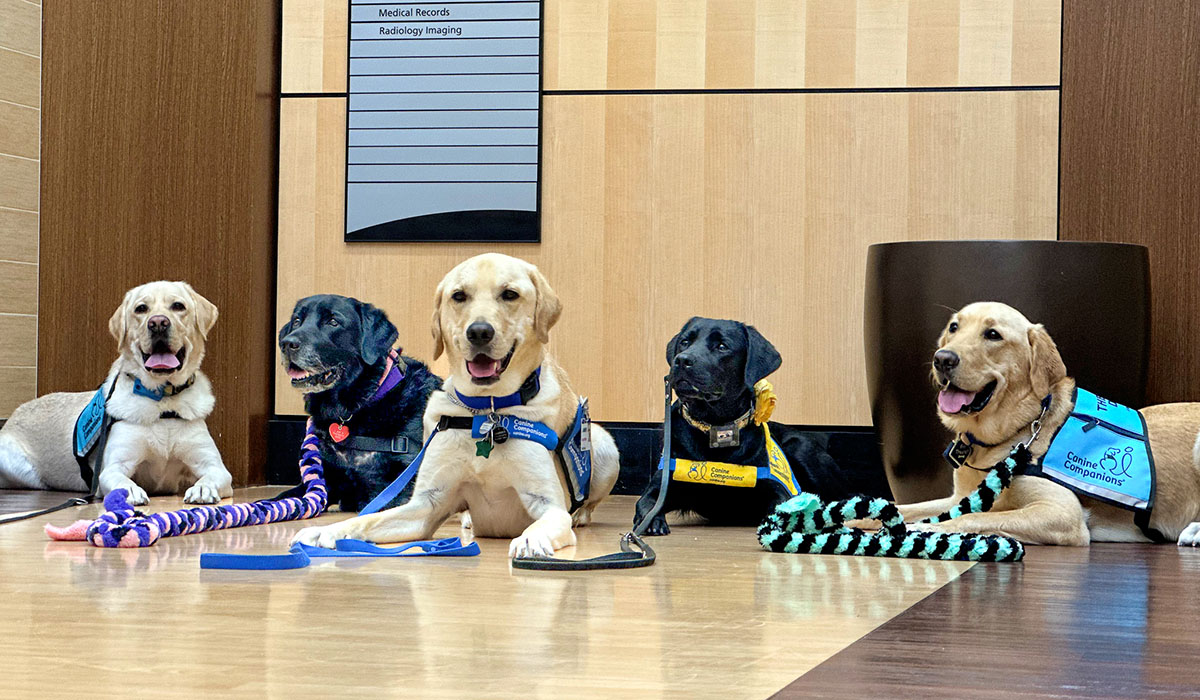
Health First facility dog Jammer, front and center, takes a doggie break with, from left, therapy dogs Vista VI and Parsley, service-pup-in-training Wallie and therapy dog Kenji.
BEYOND SIT, STAY
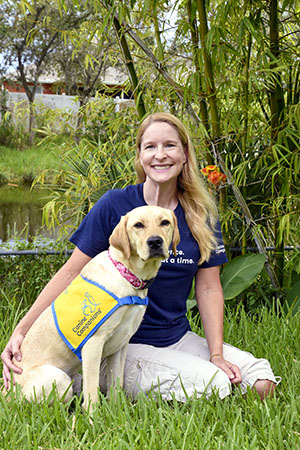
Rockledge resident Sarah Henderson is currently raising Velour, her eighth puppy for Canine Companions. At 18 months, Velour will return to Canine Companions’ Orlando campus for the advanced training needed to become a service or facility dog. JOHN HENDERSON
While therapy dogs need to be genial and well-mannered to do their jobs, a Canine Companions facility dog is more like a service dog: trained to perform more than 40 commands such as picking up items, opening doors and applying calming pressure on a patient’s body. “Jammer will walk alongside our surgical patients as they are ambulating in the hallway after their procedure,” said Michelle Sokol, nurse manager at Viera Hospital’s Joint Center.
“This exercise is critical to our patient’s recovery,” she continued. “When walking with Jammer, now their pain isn’t as noticeable and the goal of the end of the hallway doesn’t seem so far. Jammer will also attend physical therapy with our post-op patients. His presence motivates our patients to do more. Even as he is simply walking through the units, you observe patients, family members and staff smile when they stop to meet him.”
The journey from boisterous pup to focused facility or service dog begins with volunteer puppy raisers such as Sarah Henderson. The Rockledge resident is currently raising Velour, her eighth puppy for Canine Companions. The pups arrive at eight weeks of age and remain with their raisers until they are 18 months old, when they are returned to Canine Companions for advanced training. The humans’ commitment includes food, routine vet bills and coping with puppy behavior. The youngsters must also be socialized, by tagging along pretty much everywhere raisers go. The pups and their people also attend two monthly basic obedience classes.
The Health First team has its share of puppy raisers. Viera Hospital Administrator Dustin Boring and his family are puppy raisers. Volunteer Sandra Block is looking after her newest Canine Companions puppy, Wallie, who’s also learning from Block’s therapy dog, Vista VI. In November, Wallie is off to puppy college at Canine Companions. Letting go never gets easier, but puppy raisers always find comfort that the dog is destined to serve. “It’s very difficult, but we go in knowing that the dog is not ours,” Henderson said. “We are given the opportunity to love them temporarily. They are born with a purpose and our job is to help them get there.”
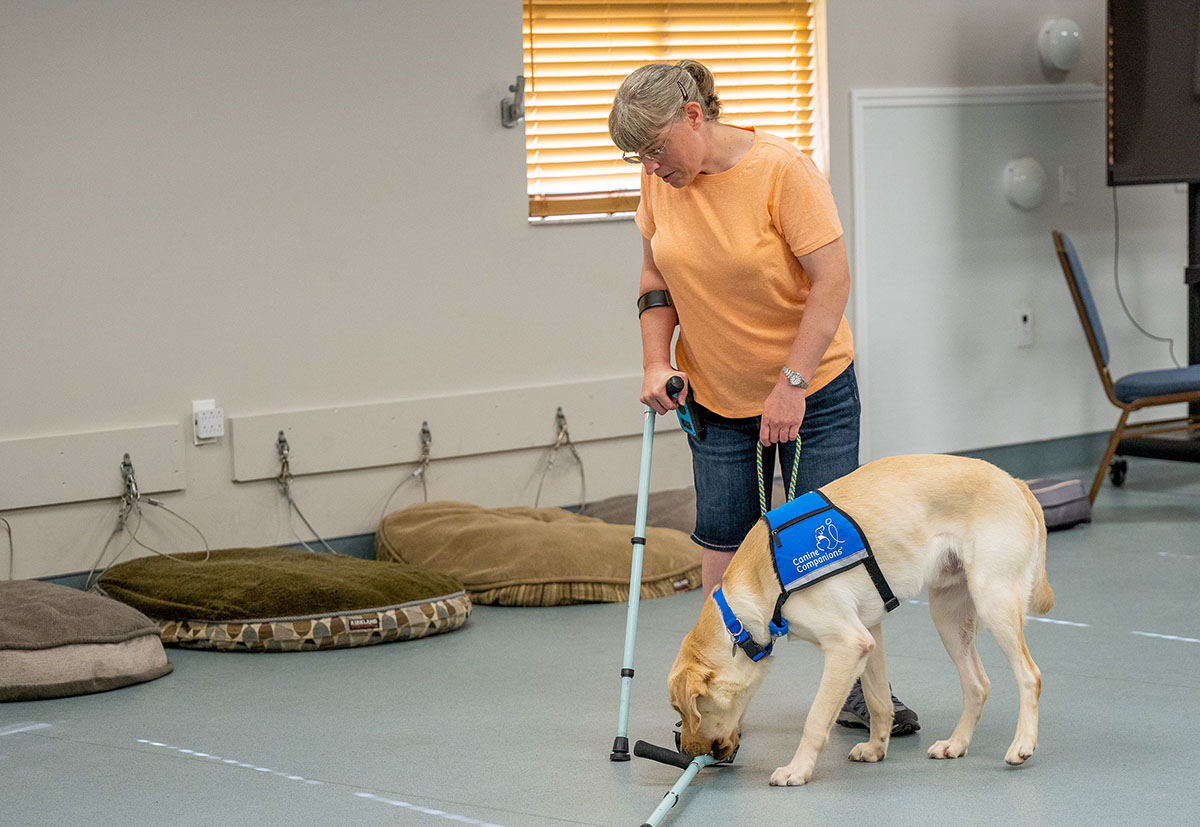
Canine Companions, which provides facility dogs at no cost to healthcare systems such as Health First, train service canines to perform duties such as picking up crutches for their humans. CANINE COMPANIONS
TOUGH CROWD
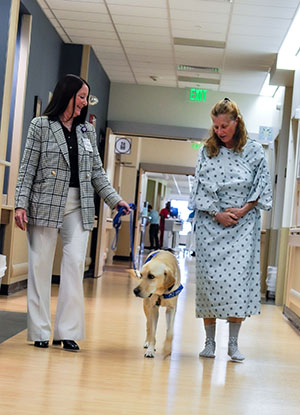
Joelle Boccabella, manager of volunteer services for Health First Community Hospitals, and facility dog Jammer walk with Viera Hospital patient Wendy Daniels. MORGAN MCNEAL
Jammer’s purpose is to encourage progress with hip or knee replacement patients. But he has enlarged his scope to include services as a stress reliever for both patients and staff at Health First’s Viera, Palm Bay and Cape Canaveral hospitals.
Before Jammer could take his place with Health First, he had to earn his advanced degree at Canine Companions. Trainers like Danielle Boggs work with the dogs throughout the day, introducing them to unfamiliar sights and sounds in real-life scenarios, honing their work ethic and teaching advanced skills. The trainers also assess where the dogs would best fit. “It is our responsibility to honor who the dogs are and to put them in the place where they will do best,” said Boggs.
Only 60 percent of puppies that enter the program graduate. Health First volunteer Jennifer Powell’s Kenji, for example, was released from service dog training because of separation anxiety and kennel stress. But he performs perfectly as a therapy canine.
Obtaining a facility dog requires a significant commitment of time and training for handlers. It was two years after Boccabella had applied that she was finally paired with Jammer. “The application was huge,” she said. “It was like adopting a child. I had to not only answer questions about myself, our facilities, our plan of daily involvement for our dogs, I had to take photos of my house. I had to give background of my involvement with dogs.”
After the application moved to the next level, Boccabella went through lengthy phone and in-person interviews. Even her walking style was examined to better make a match. Potential facility dogs had been pre-selected when she joined a Canine Companions training class for humans.
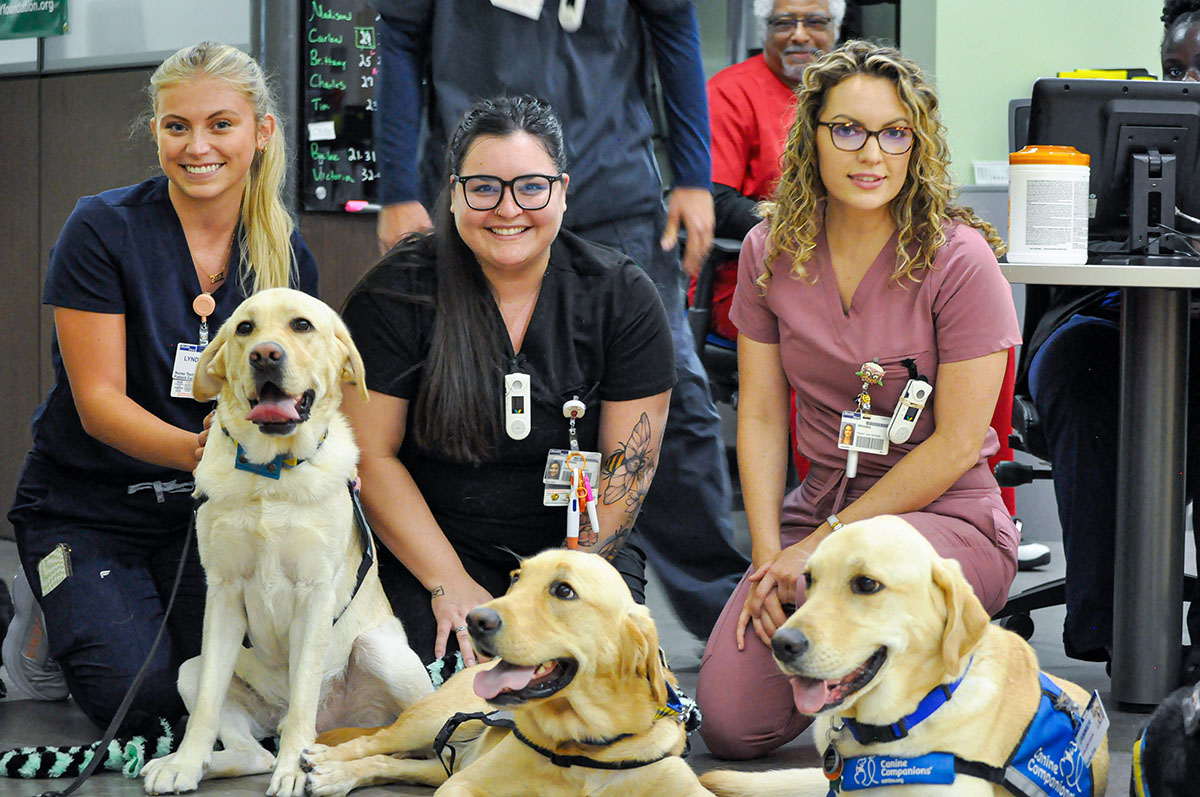
Nurse tech Lyndsi Graham, left, and nurses Marina Bouchert and Brianna Hayes visit with therapy dogs Kenji and Vista VI, along with Jammer, right. MORGAN MCNEAL PHOTOS
SIXTH SENSE
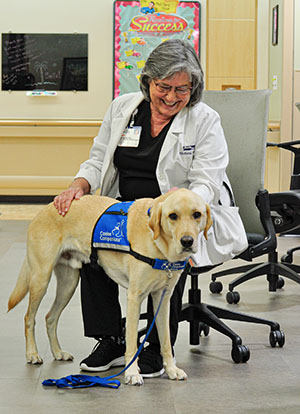
Health First Medical Group nurse practitioner Jill Polet, APRN, beams during a quick break with Jammer.
From the get-go, Jammer was the one most drawn to Boccabella and vice versa. “He was happiest with me,” she said. “You could see it when they would put him with other people. He didn’t react to them the way he did with me. It’s what they call the dog picking you.”
Although both facility and therapy dogs have been part of Health First for years, the healthcare company is actively growing the program, recently adding doctor’s offices and other outpatient services locations. Boccabella is currently bringing on six new therapy dogs but, just at Cape Canaveral Hospital alone, eight are already in the rotation. Dianna Green, director of clinical operations, is on the cusp of being matched with a new facility dog later this year. She had handled facility dog Paco, before his retirement last year.
Dogs — whether of the facility, service or therapy varieties — are undeniably positive forces in a medical environment. Hospice of Health First volunteer coordinator Sheila Wilson, who owns Parsley, recalled witnessing the interaction between Vista and an elderly deaf and blind patient. “Immediately, Vista knew this man needed him, and backed himself under his chair so his hands could touch him,” Wilson said. “The man began recounting stories of the dogs he had loved while growing up long ago. Vista kissed him on the chin.” That’s the magic of dogs. Wilson has witnessed it, time and again: “Every time you visit with a dog, something happens and it can be profound.”
See the original article in print publication

HEALTH FIRST PHOTOS




